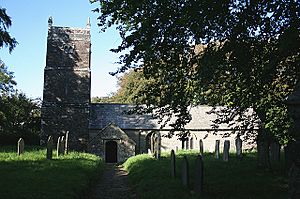St Gregory's Church, Treneglos facts for kids
Quick facts for kids St Gregory’s Church, Treneglos |
|
|---|---|

St Gregory’s Church, Treneglos
|
|
| Location | Treneglos |
| Country | England |
| Denomination | Church of England |
| History | |
| Dedication | St Gregory |
| Administration | |
| Parish | Treneglos |
| Deanery | Stratton |
| Archdeaconry | Bodmin |
| Diocese | Diocese of Truro |
| Province | Province of Canterbury |
St Gregory's Church, Treneglos is an old and important church in Treneglos, Cornwall, England. It is a Grade II* listed building. This means it is a very special historical place. It is part of the Church of England.
Contents
The Church's History
Who Built the Church?
Way back in the 1100s, a man named Robert Fitz-William owned the land where the church stands. He was a lord from a place called Downinney. Robert gave this land to a priory, which is like a monastery, in Tywardreath.
At that time, Warbstow had a small church that depended on Treneglos. Later, these two church areas joined together. Robert Fitz-William was the person who started building St Gregory's Church.
How the Church Grew Over Time
The church became bigger in the 1400s or 1500s. Workers added a special arch to the north door. They also built a north aisle, which is a side section of the church. This new part had beautiful stone patterns in the windows. Near the east end, they added a small tower for a rood loft stair. A rood loft was a gallery above the main part of the church.
In the 1500s, the south porch was added. This porch has an arch over the south door. Above this arch, there is a very old stone carving called a tympanum. This carving and the church's font might have been made by the same artist who worked on churches in Egloskerry and Tremaine.
The Norman Tympanum Carving
The old Norman tympanum carving is quite special. It shows a tree in the middle. On each side of the tree, there are two animals facing each other. Their tails are curved around their legs and over their bodies. Some people think this carving might be connected to a Bible verse from the Psalms. This verse talks about a vine and how wild animals can damage it.
Changes and Rebuilding
In the 1600s, there were very few Roman Catholics left in Cornwall. Records from 1671 show only a few people in Treneglos and other areas who still followed that faith.
In the early 1800s, Reverend J. H. Mason was the vicar. He was chosen for the role in 1804 by the Prince of Wales, who later became King George IV.
The church was rebuilt in 1858. It is dedicated to both St George and St Gregory. The church has a main area called the nave, a chancel (the area around the altar), and a north aisle. Four arches, supported by granite pillars, connect the nave to the aisle. The old tympanum carving and the font were kept safe during the rebuilding.
In 1871, the church tower was being rebuilt. By 1872, the churches of Warbstow and Treneglos were joined together as one parish. The Duke of Cornwall was the patron, meaning he supported the vicarage. In 1960, the church was officially listed as a Grade II* building, recognizing its historical importance.
Church Parish Connections
Churches in the Joint Parish
St Gregory's Church is part of a joint parish with several other churches. This means they work together. These churches include:
- St Werburgh's Church, Warbstow
- St Winwaloe's Church, Poundstock
- St Anne's Church, Whitstone
- Our Lady and St Anne's Church, Widemouth Bay
- St Gennys' Church, St Gennys
- St James' Church, Jacobstow
- St Mary the Virgin's Church, Week St Mary
The Church Organ
Details of the Pipe Organ
The church has a pipe organ that was built in 1993. It was made by a person named Mervyn Uglow. You can find more information about this organ on the National Pipe Organ Register.

